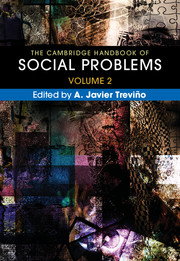Book contents
- The Cambridge Handbook of Social Problems
- The Cambridge Handbook of Social Problems
- Copyright page
- Contents
- About the Contributors
- Introduction
- Part I Problems Related to Health, Safety, and Security
- Part II Problems Related to Crime and Violence
- Chapter 12 The Problem of Crime
- Chapter 13 Corporate Malfeasance as a Social Problem
- Chapter 14 The Construction of School Bullying as a Social Problem
- Chapter 15 Rampage School Shootings
- Chapter 16 Understanding Sexual Violence: The Role of Causal and Precipitating Factors in Sexual Offending
- Chapter 17 Critical and Intersectional Understandings of Campus Sexual Assault as a Social Problem
- Chapter 18 Child Abuse and Neglect
- Chapter 19 Family Violence
- Chapter 20 Juvenile Violence
- Chapter 21 Gangs and Gang Violence
- Chapter 22 State Violence
- Chapter 23 Hate Crime
- Chapter 24 Police Brutality
- Chapter 25 Capital Punishment/Death Penalty
- Chapter 26 Wrongful Convictions: Comparative Perspectives
- Part III Problems of Global Impact
- Index
- References
Chapter 14 - The Construction of School Bullying as a Social Problem
from Part II - Problems Related to Crime and Violence
Published online by Cambridge University Press: 16 March 2018
- The Cambridge Handbook of Social Problems
- The Cambridge Handbook of Social Problems
- Copyright page
- Contents
- About the Contributors
- Introduction
- Part I Problems Related to Health, Safety, and Security
- Part II Problems Related to Crime and Violence
- Chapter 12 The Problem of Crime
- Chapter 13 Corporate Malfeasance as a Social Problem
- Chapter 14 The Construction of School Bullying as a Social Problem
- Chapter 15 Rampage School Shootings
- Chapter 16 Understanding Sexual Violence: The Role of Causal and Precipitating Factors in Sexual Offending
- Chapter 17 Critical and Intersectional Understandings of Campus Sexual Assault as a Social Problem
- Chapter 18 Child Abuse and Neglect
- Chapter 19 Family Violence
- Chapter 20 Juvenile Violence
- Chapter 21 Gangs and Gang Violence
- Chapter 22 State Violence
- Chapter 23 Hate Crime
- Chapter 24 Police Brutality
- Chapter 25 Capital Punishment/Death Penalty
- Chapter 26 Wrongful Convictions: Comparative Perspectives
- Part III Problems of Global Impact
- Index
- References
Summary
During the early twenty-first century, school bullying emerged as a social problem of epidemic proportions within academic, news media, and public discourse in the United States. Bullying has been linked to other social problems, such as mass school shootings and youth suicide. In this chapter we trace the evolution of school bullying as a social problem within academia and news media. We identify how this discourse has expanded the conceptualization and domain of school bullying and has stirred public hysteria. We also discuss how conflicting explanations of school bullying have led to confused responses at the individual, institutional, and sociocultural levels. Finally, we argue that efforts to reduce school bullying have criminalized youth behavior. We offer suggestions for a more effective approach to bullying research and prevention.
- Type
- Chapter
- Information
- The Cambridge Handbook of Social Problems , pp. 237 - 252Publisher: Cambridge University PressPrint publication year: 2018
References
- 1
- Cited by



